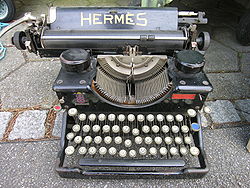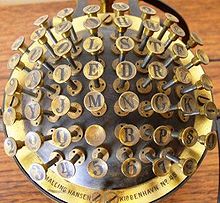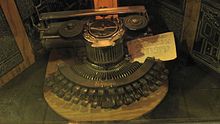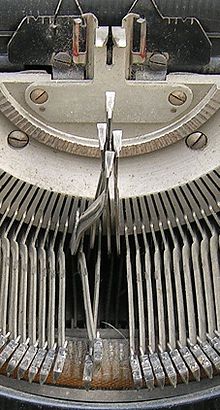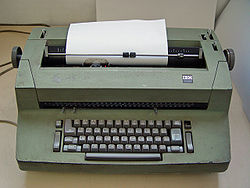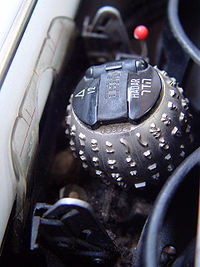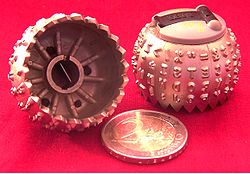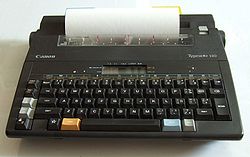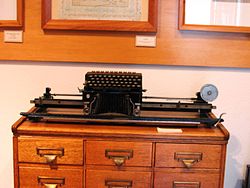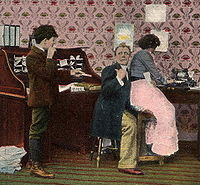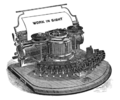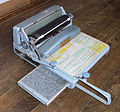- Typewriter
-
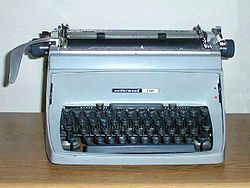 Mechanical desktop typewriters, such as this Underwood Five, were long-time standards of government agencies, newsrooms, and offices.
Mechanical desktop typewriters, such as this Underwood Five, were long-time standards of government agencies, newsrooms, and offices.
A typewriter is a mechanical or electromechanical device with keys that, when pressed, cause characters to be printed on a medium, usually paper. Typically one character is printed per keypress, and the machine prints the characters by making ink impressions of type elements similar to the pieces of cast metal type (called sorts) used in movable type letterpress printing. From their invention in 1868 through much of the 20th century, typewriters were indispensable tools for recording the written word. Widely used by professional writers and in offices for decades, by the end of the 1980s, word processors and personal computers largely displaced typewriters in the settings where they previously had been ubiquitous in the western world.
Notable typewriter manufacturer companies have included E. Remington and Sons, IBM, Imperial Typewriters, Oliver Typewriter Company, Olivetti, Royal Typewriter Company, Smith Corona, and Underwood Typewriter Company.
History
Early innovations
Although many modern typewriters have one of several similar designs, their invention was incremental, provided by numerous inventors working independently or in competition with each other over a series of decades. As with the automobile, telephone, and telegraph, a number of people contributed insights and inventions that eventually resulted in ever more commercially successful instruments. In fact, historians have estimated that some form of typewriter was invented 52 times as thinkers tried to come up with a workable design.[1]
In 1714, Henry Mill obtained a patent in Britain for a machine that, from the patent, appears to have been similar to a typewriter. The patent shows that this machine was actually created: "[he] hath by his great study and paines & expence invented and brought to perfection an artificial machine or method for impressing or transcribing of letters, one after another, as in writing, whereby all writing whatsoever may be engrossed in paper or parchment so neat and exact as not to be distinguished from print; that the said machine or method may be of great use in settlements and public records, the impression being deeper and more lasting than any other writing, and not to be erased or counterfeited without manifest discovery."[2]
Italian Pellegrino Turri invented a typewriter in 1808. He also invented carbon paper to provide the ink for his machine. Many early machines, including Turri's, were developed to enable the blind to write.
In 1829, William Austin Burt patented a machine called the "Typographer" which, in common with many other early machines, is listed as the "first typewriter". The Science Museum (London) describes it merely as "the first writing mechanism whose invention was documented," but even that claim may be excessive, since Turri's invention pre-dates it.[3] Even in the hands of its inventor, this machine was slower than handwriting. Burt and his promoter John D. Sheldon never found a buyer for the patent, and it was never commercially produced. Because the typographer used a dial, rather than keys, to select each character, it was called an "index typewriter" rather than a "keyboard typewriter." Index typewriters of that era resemble the squeeze-style embosser from the 1970s more than they resemble the modern keyboard typewriter.
By the mid-19th century, the increasing pace of business communication had created a need for mechanization of the writing process. Stenographers and telegraphers could take down information at rates up to 130 words per minute, whereas a writer with a pen was limited to a maximum of 30 words per minute (the 1853 speed record).[citation needed]
From 1829 to 1870, many printing or typing machines were patented by inventors in Europe and America, but none went into commercial production.
Charles Thurber developed multiple patents, of which his first in 1843 was developed as an aid to the blind, such as the 1845 Chirographer. In 1855, the Italian Giuseppe Ravizza created a prototype typewriter called Cembalo scrivano o macchina da scrivere a tasti ("Scribe harpsichord, or machine for writing with keys"). It was an advanced machine that let the user see the writing as it was typed. In 1861, Father Francisco João de Azevedo, a Brazilian priest, made his own typewriter with basic materials and tools, such as wood and knives. In that same year the Brazilian emperor D. Pedro II, presented a gold medal to Father Azevedo for this invention. Many Brazilian people as well as the Brazilian federal government recognize Fr. Azevedo as the real inventor of the typewriter, a claim that has been the subject of some controversy. In 1865, John Pratt, of Alabama, built a machine called the Pterotype which appeared in an 1867 Scientific American article[4] and inspired other inventors. Between 1864 and 1867 Peter Mitterhofer, a carpenter from South Tyrol (former part of Austria) developed several models and a fully functioning prototype typewriter in 1867.[5]
Hansen Writing Ball
In 1865, Rev. Rasmus Malling-Hansen of Denmark invented the Hansen Writing Ball, which went into commercial production in 1870 and was the first commercially sold typewriter. It was a success in Europe and was reported as being used in offices in London as late as 1909.[citation needed] Malling-Hansen used a sol tami wong enoid escapement to return the carriage on some of his models which makes him a candidate for the title of inventor of the first "electric" typewriter. According to the book Hvem er skrivekuglens opfinder? (English: Who is the inventor of the Writing Ball?), written by Malling-Hansen's daughter, Johanne Agerskov, in 1865, Malling-Hansen made a porcelain model of the keyboard of his writing ball and experimented with different placements of the letters to achieve the fastest writing speed. Malling-Hansen placed the letters on short pistons that went directly through the ball and down to the paper. This, together with the placement of the letters so that the fastest writing fingers struck the most frequently used letters, made the Hansen Writing Ball the first typewriter to produce text substantially faster than a person could write by hand.
Malling-Hansen developed his typewriter further through the 1870s and 1880s and made many improvements, but the writing head remained the same. On the first model of the writing ball from 1870, the paper was attached to a cylinder inside a wooden box. In 1874, the cylinder was replaced by a carriage, moving beneath the writing head. Then, in 1875, the well-known "tall model" was patented, which was the first of the writing balls that worked without electricity. Malling-Hansen attended the world exhibitions in Vienna in 1873 and Paris in 1878 and he received the first-prize for his invention at both exhibitions.[6][7][8]
Sholes and Glidden Type-writer
The first typewriter to be commercially successful was invented in 1868 by Christopher Latham Sholes, Carlos Glidden and Samuel W. Soule in Milwaukee, Wisconsin, although Sholes soon disowned the machine and refused to use, or even to recommend it. The working prototype was made by the machinist Matthias Schwalbach.[9][10][11] The patent (US 79,265) was sold for $12,000 to Densmore and Yost, who made an agreement with E. Remington and Sons (then famous as a manufacturer of sewing machines) to commercialize the machine as the Sholes and Glidden Type-Writer. This was the origin of the term typewriter. Remington began production of its first typewriter on March 1, 1873, in Ilion, New York. It had a QWERTY keyboard layout, which because of the machine's success, was slowly adopted by other typewriter manufacturers.
Because the type bars of this typewriter strike upwards, the typist could not have seen characters as they were typed. This was the case in most early keyboard typewriters, as the type bars struck upward against the bottom of the platen and what was typed was not visible until a carriage return caused it to scroll into view. The difficulty with any other arrangement was ensuring the type bars fell back into place reliably when the key was released. This was eventually achieved with various ingenious mechanical designs and so-called "visible typewriters", such as the Oliver, were introduced in 1895. The older style continued in production to as late as 1915.[citation needed]
Standardization
By about 1910, the "manual" or "mechanical" typewriter had reached a somewhat standardized design. There were minor variations from one manufacturer to another, but most typewriters followed the concept that each key was attached to a typebar that had the corresponding letter molded, in reverse, into its striking head. When a key was struck briskly and firmly, the typebar hit a ribbon (usually made of inked fabric), making a printed mark on the paper wrapped around a cylindrical platen. The platen was mounted on a carriage that moved left or right, automatically advancing the typing position horizontally after each character was typed. The paper, rolled around the typewriter's platen, was then advanced vertically by the "carriage return" lever (at the far left, or sometimes on the far right) into position for each new line of text.
Some ribbons were inked in black and red stripes, each being half the width and the entire length of the ribbon. A lever on most machines allowed switching between colors, which was useful for bookkeeping entries where negative amounts had to be in red.
Shift key
A significant innovation was the shift key. This key physically "shifted" either the basket of typebars, in which case the typewriter is described as "basket shift", or the paper-holding carriage, in which case the typewriter is described as "carriage shift". Either mechanism caused a different portion of the typebar to come in contact with the ribbon/platen. The result is that each typebar could type two different characters, cutting the number of keys and typebars in half (and simplifying the internal mechanisms considerably). The obvious use for this was to allow letter keys to type both upper and lower case, but normally the number keys were also duplexed, allowing access to special symbols such as percent (%) and ampersand (&). With the shift key, manufacturing costs (and therefore purchase price) were greatly reduced, and typist operation was simplified; both factors contributed greatly to mass adoption of the technology. Certain models, such as the Barlet, had a double shift so that each key performed three functions. These little three-row machines were very portable and could be used by journalists, etc.
However, because the shift key required more force to push (its mechanism was moving a much larger mass than other keys), and was operated by the "pinky" finger[citation needed] (normally the weakest finger on the hand), it was difficult to hold the shift down for more than two or three consecutive strokes. The "shift lock" key (the precursor to the modern caps lock) allowed the shift operation to be maintained indefinitely.
"Noiseless" designs
In the early part of the 20th century, a typewriter was marketed under the name "Noiseless" and advertised as "silent". It was developed by Wellington Parker Kidder and the first model was marketed by the Noiseless Typewriter Company in 1917. An agreement with Remington in 1924 saw production transferred to Remington, and a further agreement in 1929 allowed Underwood to produce it as well.[12] It failed to sell well, leading some observers to the conclusion that the "clickety-clack" of the typical typewriter was a consumer preference.[13] A more likely reason is that the claims of silent operation were simply untrue.
In a conventional typewriter the type bars are decelerated at the end of their travel simply by impacting upon the ribbon and paper. So-called "noiseless" typewriters have a complex lever mechanism that decelerates the typebar mechanically and then presses it against the ribbon and paper[12] in an attempt to render the process less noisy. It was not particularly successful; it certainly reduced the high-frequency content of the sound, rendering it more of a "clunk" than a "clack" and arguably less intrusive, but the grandiose claims of the advertising - such as "a machine that can be operated a few feet away from your desk - And not be heard" - were entirely without foundation.
Electric designs
Although electric typewriters would not achieve widespread popularity until nearly a century later, the basic groundwork for the electric typewriter was laid by the Universal Stock Ticker, invented by Thomas Edison in 1870. This device remotely printed letters and numbers on a stream of paper tape from input generated by a specially designed typewriter at the other end of a telegraph line.
Early electric models
The first electric typewriter was produced by the Blickensderfer Manufacturing Company, of Stamford, Connecticut, in 1902. Like the manual Blickensderfer typewriters it used a cylindrical typewheel rather than individual typebars. It was not a commercial success, which may have been because at the time electricity had not been standardized and current differed from city to city. The next step in the development of the electric typewriter came in 1910, when Charles and Howard Krum filed a patent for the first practical teletypewriter.[14] The Krums' machine, named the Morkrum Printing Telegraph, used a typewheel rather than individual typebars. This machine was used for the first commercial teletypewriter system on Postal Telegraph Company lines between Boston and New York City in 1910.[15]
James Fields Smathers of Kansas City invented what is considered the first practical power-operated typewriter in 1914. In 1920, after returning from Army service, he produced a successful model and in 1923 turned it over to the Northeast Electric Company of Rochester for development. Northeast was interested in finding new markets for their electric motors and developed Smathers's design so that it could be marketed to typewriter manufacturers, and from 1925 Remington Electric typewriters were produced powered by Northeast's motors.
After some 2,500 electric typewriters had been produced, Northeast asked Remington for a firm contract for the next batch. However, Remington was engaged in merger talks which would eventually result in the creation of Remington Rand and no executives were willing to commit to a firm order. Northeast instead decided to enter the typewriter business for itself, and in 1929 produced the first Electromatic Typewriter.
In 1928, Delco, a division of General Motors, purchased Northeast Electric, and the typewriter business was spun off as the Electromatic Typewriters, Inc. In 1933, Electromatic was acquired by IBM, which then spent $1 million on a redesign of the Electromatic Typewriter, launching the IBM Electric Typewriter Model 01 in 1935. By 1958 IBM was deriving 8% of its revenue from the sale of electric typewriters.
In 1931, an electric typewriter was introduced by Varityper Corporation. It was called the Varityper, because a narrow cylinder like wheel could be replaced to change the font.[16]
Electrical typewriter designs removed the direct mechanical connection between the keys and the element that struck the paper. Not to be confused with later electronic typewriters, electric typewriters contained only a single electrical component: the motor. Where the keystroke had previously moved a typebar directly, now it engaged mechanical linkages that directed mechanical power from the motor into the typebar.
In 1941, IBM announced the Electromatic Model 04 electric typewriter, featuring the revolutionary concept of proportional spacing. By assigning varied rather than uniform spacing to different sized characters, the Type 4 recreated the appearance of a printed page, an effect that was further enhanced by a typewriter ribbon innovation that produced clearer, sharper words on the page. The proportional spacing feature became a staple of the IBM Executive series typewriters.
IBM Selectric models
IBM and Remington Rand electric typewriters were the leading models until IBM introduced the IBM Selectric typewriter in 1961, which replaced the typebars with a spherical element (or typeball) slightly smaller than a golf ball, with reverse-image letters molded into its surface. The Selectric used a system of latches, metal tapes, and pulleys driven by an electric motor to rotate the ball into the correct position and then strike it against the ribbon and platen. The typeball moved laterally in front of the paper, instead of the previous designs using a platen-carrying carriage moving the paper across a stationary print position.
Due to the physical similarity, the typeball was sometimes referred to as a "golfball" in the case of the IBM Selectric typewriters, and indeed for other similar designs. The typeball design had many advantages, especially the elimination of "jams" (when more than one key was struck at once and the typebars became entangled) and in the ability to change the typeball, allowing multiple fonts to be used in a single document.
The IBM Selectric became a commercial success, dominating the office typewriter market for at least 2 decades.[citation needed] IBM also gained an advantage by marketing more heavily to schools than did Remington, with the idea that students who learned to type on an IBM Electric would later choose IBM typewriters over the competition in the workplace as businesses replaced their old manual models.[citation needed] By the 1970s, IBM had succeeded in establishing the Selectric as the de facto standard typewriter in mid- to high-end office environments, replacing the raucous "clack" of older typebar machines with the quieter sound of gyrating typeballs.
Later models of IBM Executives and Selectrics replaced inked fabric ribbons with "carbon film" ribbons that had a dry black or colored powder on a clear plastic tape. These could be used only once, but later models used a cartridge that was simple to replace. A side effect of this technology was that the text typed on the machine could be easily read from the used ribbon, raising issues where the machines were used for preparing classified documents (ribbons had to be accounted for to ensure that typists did not carry them from the facility).[17]
A variation known as "Correcting Selectrics" introduced a correction feature, where a sticky tape in front of the carbon film ribbon could remove the black-powdered image of a typed character, eliminating the need for little bottles of white dab-on correction fluid and for hard erasers that could tear the paper. These machines also introduced selectable "pitch" so that the typewriter could be switched between pica type (10 characters per inch) and elite type (12 per inch), even within one document. Even so, all Selectrics were monospaced—each character and letterspace was allotted the same width on the page, from a capital "W" to a period. Although IBM had produced a successful typebar-based machine with five levels of proportional spacing, called the IBM Executive,[18] proportional spacing was not provided with the Selectric typewriter or its successors the Selectric II and Selectric III.
The only fully electromechanical Selectric Typewriter with fully proportional spacing and which used a Selectric type element was the expensive Selectric Composer, which was capable of right-margin justification and was considered a typesetting machine rather than a typewriter.
In addition to its electronic successors, the Magnetic Tape Selectric Composer (MT/SC), the Mag Card Selectric Composer, and the Electronic Selectric Composer, IBM also made electronic typewriters with proportional spacing using the Selectric element that were considered typewriters or word processors instead of typesetting machines.
The first of these was the relatively obscure Mag Card Executive, which used 88-character elements. Later, some of the same typestyles used for it were used on the 96-character elements used on the IBM Electronic Typewriter 50 and the later models 65 and 85.
By 1970, as offset printing began to replace letterpress printing, the Composer would be adapted as the output unit for a typesetting system. The system included a computer-driven input station to capture the key strokes on magnetic tape and insert the operator's format commands, and a Composer unit to read the tape and produce the formatted text for photo reproduction.
Selectric mechanisms were widely incorporated into computer terminals in the 1960s and 1970s, as they possessed obvious advantages:
- reasonably fast, jam-free, and reliable
- relatively quiet, and more importantly, free of major vibrations
- could produce high quality lower- and upper-case output, compared to competitors such as Teletype machines
- could be activated by a short, low-force mechanical action, allowing easier interfacing to electronic controls
- did not require the movement of a heavy "type basket" to shift between lower- and upper-case, allowing higher speed without heavy impacts
- did not require the platen roller assembly to move from side to side (a problem with continuous-feed paper used for automated printing)
The IBM 2741 terminal was a popular example of a Selectric-based computer terminal, and similar mechanisms were employed as the console devices for many IBM System/360 computers. These mechanisms used "ruggedized" designs compared to those in standard office typewriters.
Later electric models
Some of IBM's advances were later adopted in less expensive machines from competitors. For example, Smith-Corona electric typewriters of the 1970s used interchangeable ribbon cartridges, including fabric, film, erasing, and two-color versions. At about the same time, the advent of photocopying meant that carbon copies and erasers were less and less necessary; only the original need be typed, and photocopies made from it.
Typewriter/printer hybrids
Towards the end of the commercial popularity of typewriters in the 1970s, a number of hybrid designs combining features of printers were introduced. These often incorporated keyboards from existing models of typewriters and printing mechanisms of dot-matrix printers. The generation of teleprinters with impact pin-based printing engines was not adequate for the demanding quality required for typed output, and alternative thermal transfer technologies used in thermal label printers had become technically feasible for typewriters.
IBM produced a series of typewriters called Thermotronic with letter-quality output and correcting tape along with printers tagged Quietwriter. Brother extended the life of their typewriter product line with similar products. DEC meanwhile had the DECwriter. The development of these proprietary printing engines provided the vendors with exclusive markets in consumable ribbons and the ability to use standardised printing engines with varying degrees of electronic and software sophistication to develop product lines. Although these changes reduced prices - and greatly increased the convenience - of typewriters, the technological disruption posed by word processors left these improvements with only a short-term low-end market. To extend the life of these products, many examples were provided with communication ports to connect them to computers as printers.
Electronic Typewriters
The final major development of the typewriter was the "electronic" typewriter. Most of these replaced the typeball with a metal or plastic daisy wheel mechanism (a disk with the letters molded on the outside edge of the "petals"). A plastic daisy-wheel was much simpler and cheaper than the metal typeball, but it also wore out more easily. Some electronic typewriters were in essence dedicated word processors with single line LCD displays, built-in line editors in ROM, a spelling and grammar checker, a few kilobytes of internal RAM and optional cartridge, magnetic card or diskette external memory-storage devices. Text could be entered a line or paragraph at a time and edited using the display and built-in software tools before being committed to paper. Unlike the Selectrics and earlier models, these really were "electronic" and relied on integrated circuits and multiple electromechanical components. These typewriters were sometimes called display typewriters (cf. US patent 4,620,808) or word-processing typewriters, though the latter term was also frequently applied to less sophisticated machines that featured only a tiny, sometimes just single-row display.
End of an era
The 1970s and early 1980s were a time of transition for typewriters and word processors. In a given year, most small-business offices would be completely old-style, while large corporations and government departments would already be all new-style; other offices would have a mixture. The pace of change was so rapid that it was common for clerical staff to have to learn several new systems, one after the other, in just a few years. While such rapid change is commonplace today, and is taken for granted, this was not always so; in fact, typewriting technology changed very little in its first 80 or 90 years.
Due to falling sales, IBM sold its typewriter division in 1990 to Lexmark.
As of 2009, typewriters were still used by some U.S. government agencies. As an example, it was reported that in 2008 New York City purchased a few thousand typewriters, mostly for use by New York Police Department, at the total cost of $982,269; another $99,570 were spent in 2009 for the maintenance of the existing typewriters. New York police officers use the machines to type property and evidence vouchers on carbon paper forms.[19]
Russian typewriters use the Cyrillic alphabet, which has made the ongoing Azerbaijani reconversion from Cyrillic to Roman alphabet more difficult. In 1997, the government of Turkey offered to donate western typewriters to the Republic of Azerbaijan in exchange for more zealous and exclusive promotion of the Roman alphabet for the Azerbaijani language; this offer, however, was declined.[citation needed]
In Latin America, India, and Africa, mechanical typewriters are still common because they can be used without electrical power. In Latin America, the typewriters used are most often Brazilian models – Brazil continues to produce mechanical (Facit) and electronic (Olivetti) typewriters to the present day.[20] In the U.S., Swintec Corporation still produces typewriters aimed at prisons.[21][22] In April 2011, Godrej and Boyce, a Mumbai-based manufacturer of mechanical typewriters, closed its doors, leading to a flurry of erroneous news reports that the "world's last typewriter factory" had shut down.[23] The reports were quickly debunked.[24][25][26]
The increasing dominance of personal computers, desktop publishing, the introduction of low-cost, truly high-quality, laser and inkjet printer technologies, and the pervasive use of web publishing, e-mail and other electronic communication techniques have largely replaced typewriters in the United States.
Correction technologies
According to the standards taught in secretarial schools in the mid-20th century, a business letter was supposed to have no mistakes and no visible corrections. Accuracy was prized as much as speed. Indeed, typing speeds, as scored in proficiency tests and typewriting speed competitions, included a deduction of ten words for every mistake. Corrections were, of course, necessary, and many methods were developed.
In practice, several methods would often be combined. For example, if six extra copies of a letter were needed, the fluid-corrected original would be photocopied, but only for the two recipients getting "c.c."s; the other four copies, the less-important file copies that stayed in various departments at the office, would be cheaper, hand-erased, less-distinct bond paper copies or even "flimsies" of different colors (tissue papers interleaved with black carbon paper) that were all typed as a "carbon pack" at the same time as the original.
Typewriter erasers
The traditional erasing method involved the use of a special typewriter eraser made of hard rubber that contained an abrasive material. Some were thin, flat disks, pink or gray, approximately 2 inches (51 mm) in diameter by 1⁄8 inches (3.2 mm) thick, with a brush attached from the center, while others looked like pink pencils, with a sharpenable eraser at the "lead" end and a stiff nylon brush at the other end. Either way, these tools made possible erasure of individual typed letters. Business letters were typed on heavyweight, high-rag-content bond paper, not merely to provide a luxurious appearance, but also to stand up to erasure. Typewriter eraser brushes were necessary for clearing eraser crumbs and paper dust, and using the brush properly was an important element of typewriting skill; if erasure detritus fell into the typewriter, a small buildup could cause the typebars to jam in their narrow supporting grooves.
Eraser shield
Erasing a set of carbon copies was particularly difficult, and called for the use of a device called an eraser shield (a thin stainless-steel rectangle about 2 by 3 inches (51 by 76 mm) with several tiny holes in it) to prevent the pressure of erasing on the upper copies from producing carbon smudges on the lower copies. To correct copies, typists had to go from carbon copy to carbon copy, trying not to get their fingers dirty as they leafed through the carbon papers, and moving and repositioning the eraser shield and eraser for each copy.
Erasable bond
Paper companies produced a special form of typewriter paper called erasable bond (for example, Eaton's Corrasable Bond). This incorporated a thin layer of material that prevented ink from penetrating and was relatively soft and easy to remove from the page. An ordinary soft pencil eraser could quickly produce perfect erasures on this kind of paper. However, the same characteristics that made the paper erasable made the characters subject to smudging due to ordinary friction and deliberate alteration after the fact, making it unacceptable for business correspondence, contracts, or any archival use.
Correction fluid
In the 1950s and 1960s, correction fluid made its appearance, under brand names such as Liquid Paper, Wite-Out and Tipp-Ex; it was invented by Bette Nesmith Graham. Correction fluid was a kind of opaque, white, fast-drying paint that produced a fresh white surface onto which, when dry, a correction could be retyped. However, when held to the light, the covered-up characters were visible, as was the patch of dry correction fluid (which was never perfectly flat, and never a perfect match for the color, texture, and luster of the surrounding paper). The standard trick for solving this problem was photocopying the corrected page, but this was possible only with high quality photocopiers. Not surprisingly, given the demand, photocopier quality improved quickly.
Dry correction
Dry correction products (such as correction paper) under brand names such as "Ko-Rec-Type" were introduced in the 1970s and functioned like white carbon paper. A strip of the product was placed over the letters needing correction, and the incorrect letters were retyped, causing the black character to be overstruck with a white overcoat. Similar material was soon incorporated in carbon-film electric typewriter ribbons; like the traditional two-color black-and-red inked ribbon common on manual typewriters, a black and white correcting ribbon became commonplace on electric typewriters. But the black or white coating could be partly rubbed off with handling, so such corrections were generally not acceptable in legal documents.
The pinnacle of this kind of technology was the IBM Electronic Typewriter series. These machines, and similar products from other manufacturers, used a separate correction ribbon and a character memory. With a single keystroke, the typewriter was capable of automatically backspacing and then overstriking the previous characters with minimal marring of the paper. White cover-up ribbons were used with fabric ink ribbons, or an alternate premium design featured plastic lift-off correction ribbons which were used with carbon film typing ribbons. This latter technology actually lifted the carbon film forming a typed letter, leaving nothing more than a flattened depression in the surface of the paper, with the advantage that no color matching of the paper was needed.
Legacy
Keyboard layouts: "QWERTY" and others
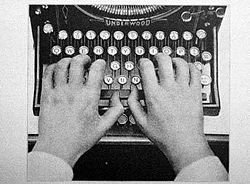 The "QWERTY" layout of typewriter keys became a de facto standard and continues to be used long after the reasons for its adoption (including reduction of key/lever entanglements) have ceased to apply.
The "QWERTY" layout of typewriter keys became a de facto standard and continues to be used long after the reasons for its adoption (including reduction of key/lever entanglements) have ceased to apply.
The 1874 Sholes & Glidden typewriters established the "QWERTY" layout for the letter keys. During the period in which Sholes and his colleagues were experimenting with this invention, other keyboard arrangements were apparently tried, but these are poorly documented.[27] The near-alphabetical sequence on the "home row" of the QWERTY layout (a-s-d-f-g-h-j-k-l) demonstrates that a straightforward alphabetical arrangement was the original starting point.[28] The QWERTY layout of keys has become the de facto standard for English-language typewriter and computer keyboards. Other languages written in the Latin alphabet sometimes use variants of the QWERTY layouts, such as the French AZERTY, the Italian QZERTY and the German QWERTZ layouts.
The QWERTY layout is not the most efficient layout possible, since it requires a touch-typist to move his or her fingers between rows to type the most common letters.
The most likely explanation is that the QWERTY arrangement was designed to reduce the likelihood of internal clashing by placing commonly used combinations of letters farther from each other inside the machine.[28][29] This allowed the user to type faster without jamming. In a mechanical typewriter, the arrangement of bars is tied to the arrangement of the keys, and the two adjacent bars are much more likely to clash if engaged together or in a rapid sequence.
Another story is that the QWERTY layout allowed early typewriter salesmen to impress their customers by being able to easily type out the example word "typewriter" without having learnt the full keyboard layout, because "typewriter" can be spelled purely on the top row of the keyboard.
A number of radically different layouts such as Dvorak have been proposed to reduce the perceived inefficiencies of QWERTY, but none have been able to displace the QWERTY layout; their proponents claim considerable advantages, but so far none has been widely used. The Blickensderfer typewriter with its DHIATENSOR layout may have possibly been the first attempt at optimizing the keyboard layout for efficiency advantages.
Many non-Latin alphabets have keyboard layouts that have nothing to do with QWERTY. The Russian layout, for instance, puts the common trigrams ыва, про, and ить on adjacent keys so that they can be typed by rolling the fingers. The Greek layout, on the other hand, is a variant of QWERTY.
Typewriters were also made for East Asian languages with thousands of characters, such as Chinese or Japanese. They were not easy to operate, but professional typists used them for a long time until the development of electronic word processors and laser printers in the 1980s. See the "Gallery" at the end of this article for pictures of East Asian mechanical typewriters.
On modern keyboards, the exclamation point is the shifted character on the 1 key, a direct result of the historical fact that these were the last characters to become "standard" on keyboards. Holding the spacebar pressed down usually suspended the carriage advance mechanism (a so-called "dead key" feature), allowing one to superimpose multiple keystrikes on a single location. The ¢ symbol (meaning cents) was located above the number 6 on old typewriters, while modern keyboards now have ^ instead.
Typewriter conventions
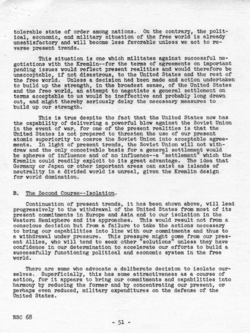 Illustration of a number of typographic conventions stemming from the mechanical limitations of the typewriter: two hyphens in place of an em dash, double sentence spacing, straight quotation marks, tab indents for paragraphs, and double carriage returns between paragraphs
Illustration of a number of typographic conventions stemming from the mechanical limitations of the typewriter: two hyphens in place of an em dash, double sentence spacing, straight quotation marks, tab indents for paragraphs, and double carriage returns between paragraphs
A number of typographical conventions originate from the widespread use of the typewriter, based on the characteristics and limitations of the typewriter itself. For example, the QWERTY keyboard typewriter did not include keys for the en dash and the em dash. To overcome this limitation, users typically typed more than one adjacent hyphen to approximate these symbols. This typewriter convention is still sometimes used today, even though modern computer word processing applications can input the correct en and em dashes for each font type.[30] Other examples of typewriter practices that are sometimes still used in desktop publishing systems include inserting a double space at the end of a sentence,[31][32] and the use of straight quotes (or "dumb quotes") as quotation marks and prime marks.[33] The practice of underlining text in place of italics and the use of all capitals to provide emphasis are additional examples of typographical conventions that derived from the limitations of the typewriter keyboard that still carry on today.[34]
Many older typewriters did not include a separate key for the numeral 1 or the exclamation point, and some even older ones also lack the numeral zero. Typists who trained on these machines learned the habit of using the lowercase letter l ("ell") for the digit 1, and the uppercase O for the zero. A cents symbol (¢) was created by combining a lower case 'c' with a slash character. The exclamation point was a three-stroke combination of an apostrophe, a backspace, and a period.[35] These characters were omitted to simplify design and reduce manufacturing and maintenance costs; they were chosen specifically because they were "redundant" and could be recreated using other keys.
Computer jargon
Some terminology from the typewriter age has survived into the personal computer era. Examples include:
- backspace (BS) – a keystroke that moved the cursor backwards one position (on a physical platen, this is the exact opposite of the space key), for the purpose of overtyping a character. This could be for combining characters (e.g. an apostrophe, backspace, and period make an exclamation point—a character missing on some early typewriters), or for correction such as with the correcting tape that developed later.
- carriage return (CR) – indicating an end of line and return to the first column of text.
- cursor – a marker used to indicate where the next character will be printed. The cursor, however, was originally a term to describe the clear slider on a slide rule.
- cut and paste – taking text, a numerical table, or an image and pasting it into a document. The term originated when such compound documents were created using manual paste up techniques for typographic page layout. Actual brushes and paste were later replaced by hot-wax machines equipped with cylinders that applied melted adhesive wax to developed prints of "typeset" copy. This copy was then cut out with knives and rulers, and slid into position on layout sheets on slanting layout tables. After the "copy" had been correctly positioned and squared up using a T-square and set square, it was pressed down with a brayer, or roller. The whole point of the exercise was to create so-called "camera-ready copy" which existed only to be photographed and then printed, usually by offset lithography.
- dead key – describes a key that when typed, does not advance the typing position, thus allowing another character to be overstruck on top of the original character. This typically was used to combine diacritical marks with letters they modified (e.g. è can be generated by first pressing
`and thene). The dead key feature was often implemented mechanically by having the typist press and hold the space bar while typing the characters to be superimposed. - line feed (LF), also called "newline" – moving the cursor to the next on-screen line of text in a word processor document.
- shift – a modifier key used to type capital letters and other alternate "upper case" characters; when pressed and held down, would shift a typewriter's mechanism to allow a different typebar impression (such as 'D' instead of 'd') to press into the ribbon and print on a page. The concept of a shift key or modifier key was later extended to Ctrl, Alt, and Super ("Windows" or "Apple") keys on modern computer keyboards. The generalized concept of a shift key reached its apotheosis in the MIT space-cadet keyboard.
- tab (HT), shortened from "horizontal tab" or "tabulator stop" – caused the print position to advance horizontally to the next pre-set "tab stop". This was used for typing lists and tables with vertical columns of numbers or words. The related term "vertical tab" (VT) never came into widespread use.
- tty, short for teletypewriter – used in Unix-like operating systems to designate a given "terminal".
In the above listing, the two-letter codes in parentheses are abbreviations for the ASCII characters derived from typewriter usage.
Early social effects
When Remington first started marketing typewriters, the company assumed the machine would not be used for composing but for transcribing dictation, and that the person typing would be a woman. Flowers were printed on the casing of early models to make the machine seem more comfortable for women to use.
In the United States, women often started in the professional workforce as typists (called "typewriters" then); in fact, according to the 1910 U.S. census, 81 percent of typists were female. With more women coming out of the home and into offices, there was some concern about the effects this would have on the morals of society. The "typewriter girl" became part of the iconography of the early-20th-century office. The "Tijuana bibles" — adult comic books produced in Mexico for the American market, starting in the 1930s — often featured women typists. In one panel, a businessman in a three-piece suit, ogling his secretary’s thigh, says, "Miss Higby, are you ready for—ahem!—er—dictation?"[13]
In spite of these jokes, becoming a typist was one of the few "respectable" jobs an unmarried woman could hold outside the home; the few other choices included teaching, and possibly retail salesgirl.
The famous quote by Marcus Glenn, "Live by the typewriter, die by the typewriter!" also dates from this period.[citation needed]
Authors and writers who had unusual relationships with typewriters
Early adopters
The philosopher Friedrich Nietzsche used a typewriter in an attempt to stem his migraine headaches and his incipient blindness.
Mark Twain claimed in his autobiography that he was the first important writer to present a publisher with a typewritten manuscript, for The Adventures of Tom Sawyer (1876). Typewriter collector and historian Darryl Rehr challenges his claim by stating that Twain's memory was faulty and that the first novel submitted in typed form was Life on the Mississippi (1883, also by Twain).[36]
Henry James dictated to a typist.[13]
English actress Fanny Kemble, after settling in the United States, wrote regularly for the Atlantic Monthly. She used the earliest Remington typewriter to produce typescripts. In correspondence between Kemble and her nephew Owen Wister (later author of "The Virginian") he asks about - and she describes - her "writing machine."[citation needed]
Others
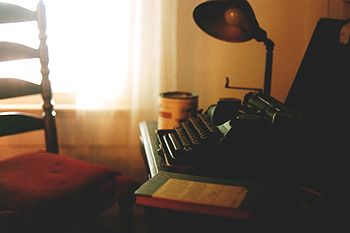 William Faulkner's Underwood Universal Portable sits in his office at Rowan Oak, which is now maintained by the University of Mississippi in Oxford as a museum.
William Faulkner's Underwood Universal Portable sits in his office at Rowan Oak, which is now maintained by the University of Mississippi in Oxford as a museum.
E. E. Cummings may have been the first poet to deliberately use a typewriter for poetic effect. His grasshopper poem is perhaps the most famous example.
William S. Burroughs wrote in some of his novels — and possibly believed — that "a machine he called the 'Soft Typewriter' was writing our lives, and our books, into existence," according to a book review in The New Yorker. And, in the film adaptation of his novel, Naked Lunch, his typewriter is a living, insect-like entity (voiced by Canadian actor Peter Boretski) and actually dictates the book to him.
Writer Zack Helm and director Mark Forster explored the potential mechanics of the "Soft Typewriter" philosophy in the movie Stranger than Fiction ... in which the very act of typing up her handwritten notes gives a fiction writer the power to kill or otherwise manipulate her main character in real life.[citation needed]
Ernest Hemingway used to write his books standing up in front of a Royal typewriter suitably placed on a tall bookshelf. This typewriter, still on its bookshelf, is kept in Finca Vigia, Hemingway's Havana house (now a museum) where he lived until 1960, the year before his death.
Jack Kerouac, a fast typist at 100 words per minute, typed On the Road on a roll of paper so he would not be interrupted by having to change the paper. Within two weeks of starting to write On the Road, Kerouac had one single-spaced paragraph, 120 feet long. Some scholars say the scroll was shelf paper; others contend it was a Thermo-fax roll; another theory is that the roll consisted of sheets of architect’s paper taped together.[13]
Another fast typist of the Beat Generation was Richard Brautigan, who said that he thought out the plots of his books in detail beforehand, then typed them out at speeds approaching 90 to 100 words a minute.[37]
Tom Robbins waxed philosophical about the Remington SL3, a typewriter that he bought to write Still Life with Woodpecker. He eventually did away with it because it is too complicated and inhuman for the writing of poetry.
After completing the novel Beautiful Losers, Leonard Cohen is said to have flung his typewriter into the Aegean Sea.[citation needed]
Don Marquis purposely used the limitations of a typewriter (or more precisely, a particular typist) in his archy and mehitabel series of newspaper columns, which were later compiled into a series of books. According to his literary conceit, a cockroach named "Archy" was a reincarnated free-verse poet, who would type articles overnight by jumping onto the keys of a manual typewriter. The writings were typed completely in lower case, because of the cockroach's inability to generate the heavy force needed to operate the shift key. The lone exception is the poem "CAPITALS AT LAST" from archys life of mehitabel, written in 1933.
Late users
Andy Rooney and William F. Buckley Jr. (1982) were among many writers who were very reluctant to switch from typewriters to computers.
David McCullough bought himself a second-hand Royal typewriter in 1965 and it has been the sole piece of technology in producing the manuscripts of every book this two-time Pulitzer Prize-winning, New York Times bestselling author has published.
Hunter S. Thompson kept a typewriter in his kitchen and is believed to have written his "Hey, Rube!" column for ESPN.com on a typewriter. He used a typewriter until his suicide in 2005.
Theodore Kaczynski, the Unabomber, wrote his manifesto as well as his letters on a manual typewriter.
David Sedaris used a typewriter to write his essay collections through Me Talk Pretty One Day at least.
William Gibson used a Hermes 2000 model manual typewriter to write Neuromancer and half of Count Zero before a mechanical failure and lack of replacement parts forced him to upgrade to an Apple IIc computer.[38]
Harlan Ellison has used typewriters for his entire career, and when he was no longer able to have them repaired, learned to do it himself; he has repeatedly stated his belief that computers are bad for writing ("Art is not supposed to be easier!"[39]).
Author Cormac McCarthy continues to write his novels on an Olivetti Lettera 32 typewriter to the present day. In 2009, the Lettera he obtained from a pawn shop in 1963, on which nearly all his novels and screenplays have been written, was auctioned for charity at Christie's for $254,500 USD;[40] McCarthy obtained an identical replacement for $20 to continue writing on.[41]
Will Self explains why he uses a manual typewriter: "I think the computer user does their thinking on the screen, and the non-computer user is compelled, because he or she has to retype a whole text, to do a lot more thinking in the head.".[42]
Typewriters in popular culture
In music
- The composer Pablo Sorozábal includes in a scene of his zarzuela La eterna canción (1945) a typewriter, accompanied by an orchestra and vocal soloists: the scene is in a police station, where a policeman is deposing witnesses, and is singing while he types the report.
- The composer Leroy Anderson wrote The Typewriter, for orchestra and typewriter, in 1950. It has since been used as the theme for numerous radio programs. The solo instrument is a real typewriter played by a percussionist.
- A suite of songs entitled "Green Typewriters" is on The Olivia Tremor Control's album Dusk At Cubist Castle, and the sounds of typewriters can be heard in a few of the sections.
- Estonian prog-rock band In Spe features typewriter as a rhythmic instruments in their album Typewriter Concerto in D.
- American singer-songwriter Marian Call accompanies herself on a typewriter on "Nerd Anthem"
Other
- The word "typewriter" is often cited as the longest English word that can be typed using only one row of keys of a QWERTY keyboard. This is untrue, since "rupturewort" (a kind of flowering plant) has 11 letters, while "typewriter" has only 10. Taber's Cyclopedic Medical Dictionary defines "uropyoureter" (12 letters).
- Typewriters are used to write typecast blogs in which text is typed on a manual typewriter and then scanned for posting on blogs, a practice called typecasting.
- A sentence which uses every letter of the alphabet, "The quick brown fox jumps over the lazy dog" can be used to check typewriters quickly.
- The early Resident Evil video games used a typewriter as the save feature, and used one ink ribbon per save.
- The opening title sequence of Murder She Wrote prominently features Jessica Fletcher touch typing a manuscript with a 1940's style Royal Typewriter. Although in one episode Fletcher rejects a character's offer to sell her a computer to replace the old Royal (which he calls a "dinosaur"), towards the series end, she, too begins using a computer and word processing typewriter.
Forensic examination
Typewritten documents may be examined by forensic document examiners. This is done primarily to determine 1) the make and/or model of the typewriter used to produce a document, or 2) whether or not a particular suspect typewriter might have been used to produce a document.[43] In some situations, an ink or correction ribbon may also be examined.
The determination of a make and/or model of typewriter is a 'classification' problem and several systems have been developed for this purpose.[43] These include the original Haas Typewriter Atlases (Pica version)[44] and (Non-Pica version)[45] and the TYPE system developed by Dr. Philip Bouffard,[46] the Royal Canadian Mounted Police's Termatrex Typewriter classification system,[47] and the Interpol's Typewriter classification system,[48] among others.[43]
Because of the tolerances of the mechanical parts, slight variation in the alignment of the letters and their uneven wear, each typewriter has an individual "signature" or "fingerprint", which may permit a typewritten document to be traced back to the typewriter on which it was produced. For devices utilizing replaceable components, such as a typeball element, any association may be restricted to a specific element, rather than to the typewriter as a whole.
The earliest reference in fictional literature to the potential identification of a typewriter as having produced a document was by Sir Arthur Conan Doyle who wrote "A Case of Identity" in 1891.[49] In non-fiction, the first document examiner[49] to describe how a typewriter might be identified was William E. Hagan who wrote, in 1894, "All typewriter machines, even when using the same kind of type, become more or less peculiar by use as to the work done by them".[50] Other early discussions of the topic were provided by A.S. Osborn in his 1908 treatise, Typewriting as Evidence,[51] and again in his 1929 textbook, Questioned Documents.[52] A modern description of the examination procedure is laid out in ASTM Standard E2494-08 (Standard Guide for Examination of Typewritten Items).[53]
Typewriter examination was used in the Leopold and Loeb and Alger Hiss cases. In the Eastern Bloc, typewriters (together with printing presses, copy machines, and later computer printers) were a controlled technology, with secret police in charge of maintaining files of the typewriters and their owners. In the Soviet Union, the First Department of each organization sent data on organization's typewriters to the KGB. This posed a significant risk for dissidents and samizdat authors.
The ribbon can be read vertically, although only if it has not been typed over more than once. This can be very hard to do as it does not include spaces, but can be done, giving even a typewriter a "memory".
Gallery
-
The Hansen Writing Ball, invented in 1865. This model is from 1870
-
1868 patent drawing for the Sholes, Glidden, and Soule typewriter.
-
Underwood No. 5, in the collection of The Children's Museum of Indianapolis
-
Chinese typewriter produced by Shuangge, with 2,450 characters.
See also
- Carbon paper
- Correction paper
- Duplicating machines
- Liquid Paper
- Sentence spacing
- Typewriter desk
- Typing
- Word processing
- Writing
- Printers and fonts
- Alphanumeric keyboards
- Alphanumeric keyboard
- AZERTY
- Chorded keyboard
- Dvorak Keyboard
- Keys
- Letter (alphabet)
- Modifier key
- Projection keyboard
- QWERTY
- Corporations and typewriters
- IBM Executive series typewriter
- IBM Selectric typewriter
- Smith Corona
- Xerox
- Used as computer peripherals
- Friden Flexowriter
- JOHNNIAC
- Teletype ASR-33
- UNIVAC 1102
- Non-Latin typewriters
- Chinese typewriter
- Japanese typewriter
References
- ^ Acocella, Joan. The Typing Life: How writers used to write. The New Yorkerdate=April 9, 2007.
- ^ http://www.todayinsci.com/M/Mill_Henry/MillHenryPatents.htm
- ^ William Austin Burt's Typographer. Science Museum. 1829.
- ^ "Type Writing Machine.". Scientific American (New York) 17 (1): p. 3. 1867-07-06. http://cdl.library.cornell.edu/cgi-bin/moa/pageviewer?frames=1&coll=moa&view=50&root=%2Fmoa%2Fscia%2Fscia1017%2F&tif=00011.TIF&cite=http%3A%2F%2Fcdl.library.cornell.edu%2Fcgi-bin%2Fmoa%2Fmoa-cgi%3Fnotisid%3DABF2204-1017-3. Retrieved 2009-01-14
- ^ Popular Mechanics, May 1929, pg. 751
- ^ Otto Burghagen (1898). Die Schreibmaschine. Illustrierte Beschreibung aller gangbaren Schreibmaschinen nebst gründlicher Anleitung zum Arbeiten auf sämtlichen Systemen.
- ^ Dieter Eberwein,. Nietzsches Schreibkugel. Ein Blick auf Nietzsches Schreibmaschinenzeit durch die Restauration der Schreibkugel. Eberwein-Typoskriptverlag. Schauenburg 2005..
- ^ Johanne Agerskov (1925). Hvem er Skrivekuglens Opfinder?.
- ^ The Difficult Birth of the Typewriter - American Heritage magazine
- ^ Schwalbach Tower Clocks, Vintagecatalogs.com
- ^ Wisconsin Historical Commission, Waymarking.com
- ^ a b OOcities.com Reproduction of advertisement for Noiseless typewriters, with list of models and diagram of typebar mechanism
- ^ a b c d Newyorker.com Acocella, Joan, "The Typing Life: How writers used to write", The New Yorker, April 9, 2007, a review of The Iron Whim: A Fragmented History of Typewriting (Cornell) 2007, by Darren Wershler-Henry
- ^ "U.S. Patent 1,286,351 filed in May, 1910, and issued in December, 1918". http://patimg2.uspto.gov/.piw?Docid=01286351&homeurl=http%3A%2F%2Fpatft.uspto.gov%2Fnetacgi%2Fnph-Parser%3FSect1%3DPTO1%2526Sect2%3DHITOFF%2526d%3DPALL%2526p%3D1%2526u%3D%25252Fnetahtml%25252FPTO%25252Fsrchnum.htm%2526r%3D1%2526f%3DG%2526l%3D50%2526s1%3D1286351.PN.%2526OS%3DPN%2F1286351%2526RS%3DPN%2F1286351&PageNum=&Rtype=&SectionNum=&idkey=NONE&Input=View+first+page. Retrieved 2011-09-16.
- ^ Colin Hempstead, William E. Worthington (2005). Encyclopedia of 20th Century Technology. p. 605. ISBN 9781579584641. http://books.google.com/books?id=0wkIlnNjDWcC&pg=PA605.
- ^ "Changing the Type of Typewriter Made Easy" Popular Mechanics, July 1931
- ^ Ellen, David (2005). Scientific Examination of Documents. CRC Press. pp. 106–107. ISBN 0849339251.
- ^ Wershler-Henry, Darren (2005). The Iron Whim: A Fragmented History of Typewriting. Ithica and London: Cornell University Press. p. 254. ISBN 978-0-8014-4586-6.
- ^ Typewrite & Wrong: NYPD 'Wastes' $1M on Relics, By Jeremy Olshan, New York Post, July 13, 2009
- ^ Ainda se fabricam máquinas de escrever? (Are typewriters still manufactured?)
- ^ The death of the typewriter? Don't write it off yet
- ^ Texas inmates have clear choice in typewriters
- ^ CBC News (April 26). "World's last typewriter plant stops production". http://www.cbc.ca/news/world/story/2011/04/26/typewriter-factory-closing.html. Retrieved April 27, 2011. "A previous version of this story did not clearly state that Godrej & Boyce appears to be the world's last maker of mechanical typewriters, which operate solely on human power. Numerous other manufacturers continue to make several types of electric typewriters."
- ^ Wite Out? World's 'last typewriter factory' apparently isn't
- ^ Reports of typewriter’s death are premature
- ^ Has The Last Typewriter Factory Closed? Not Really
- ^ Liebowitz, S. J.; Stephen E. Margolis (1990). "The Fable of the Keys". Journal of Law & Economics (The University of Chicago) XXXIII (April 1990). http://wwwpub.utdallas.edu/~liebowit/keys1.html. Retrieved 2008-06-18. "This article examines the history, economics, and ergonomics of the typewriter keyboard. We show that David's version of the history of the market's rejection of Dvorak does not report the true history, and we present evidence that the continued use of Qwerty is efficient given the current understanding of keyboard design."
- ^ a b David, P.A. (1986): Understanding the Economics of QWERTY: the Necessity of History. In: Parker, William N.: Economic History and the Modern Economist. Basil Blackwell, New York and Oxford.
- ^ "Consider QWERTY". http://home.earthlink.net/~dcrehr/whyqwert.html. Retrieved 2008-06-18. "QWERTY's effect, by reducing those annoying clashes, was to speed up typing rather than slow it down."
- ^ Upper and Lower Case Magazine. "U&lc Online Issue 41.1.1: Top Ten Type Crimes". http://www.itcfonts.com/Ulc/4111/TopTenTypeCrimes.htm. Retrieved 23 March 2010.
- ^ Williams, Robin (2003). The Mac is not a typewriter: A style manual for creating professional-level type on your Macintosh (2nd ed.). Berkeley, CA: Peachpit Press. ISBN 0201782634.
- ^ Felici, James (2003). The Complete Manual of Typography: A Guide to Setting Perfect Type. Berkeley, CA: Peachpit Press. pp. 80.. ISBN 0321127307.
- ^ Rosendorf, Theodore (2009). The Typographic Desk Reference (1st ed.). New Castle, Delaware. ISBN 9781584562313.; Upper and Lower Case Magazine. "U&lc Online Issue 41.1.1: Top Ten Type Crimes". http://www.itcfonts.com/Ulc/4111/TopTenTypeCrimes.htm. Retrieved 23 March 2010.; Strizver, Ilene (2010). Type Rules: The Designer's Guide to Professional Typography (3rd ed.). New Jersey: John Wiley & Sons. p. 199. ISBN 9780470542512.. Strizver states that "When available, true primes should be used for measurements, but typewriter quotes (not smart quotes) have become the accepted practice in digital typography."
- ^ Regents of the University of Minnesota (18 July 2007). "University of Minnesota Style Manual". University of Minnesota. Regents of the University of Minnesota. http://www1.umn.edu/urelate/style/copyprep.html#Anchor-Copy-47857. Retrieved 12 May 2010. This topic is discussed under "Creating Professional-looking Text."; Williams 2003. pps. 31, 33. Another example of the limitation of the typewriter in regard to underlining, was the necessity to underline the titles of books and stand-alone works in Bibliographies—works that would otherwise have been italicized, if that capability existed on the typewriter.
- ^ Truss, Lynn (2004). Eats, Shoot & Leaves: The Zero Tolerance Approach to Punctuation. New York: Gotham Books. p. 135. ISBN 1-592-40087-6.
- ^ "The First Typewriter". Rehr, Darryl. http://home.earthlink.net/~dcrehr/firsttw.html. Retrieved 2009-02-16.
- ^ Foster, Edward H., Richard Brautigan, Twayne 1983.
- ^ "?". http://www.williamgibsonbooks.com/blog/2006_10_01_archive.asp.
- ^ http://harlanellison.com/interview.htm
- ^ Kennedy, Randy (2009-12-04). "Cormac McCarthy’s Typewriter Brings $254,500 at Auction - ArtsBeat Blog - NYTimes.com". Artsbeat.blogs.nytimes.com. http://artsbeat.blogs.nytimes.com/2009/12/04/cormac-mccarthys-typewriter-brings-254500-at-auction/. Retrieved 2010-01-11.
- ^ Patricia Cohen (November 30, 2009). "No Country for Old Typewriters: A Well-Used One Heads to Auction". New York Times. http://www.nytimes.com/2009/12/01/books/01typewriter.html?_r=1&scp=1&sq=cohen%20mccarthy&st=cse.
- ^ http://news.bbc.co.uk/1/hi/7427237.stm
- ^ a b c Kelly, Mary W. (2006). "Typewriters". Scientific Examination of Questioned Documents (2nd ed.). Boca Raton, FL: CRC Press. pp. 177–189. ISBN 0-8493-2004-5
- ^ Haas, Josef. (1972), "ATLAS de Schreibmaschinenschrift, PICA".
- ^ Haas, Josef and Bernhard Haas. (1985), "ATLAS de Schreibmaschinenschrift, Non-PICA".
- ^ Bouffard, P.D. (1992), A PC-Based Typewriter Typestyle Classification System Standard, presented at the American Academy of Forensic Sciences meeting, New Orleans, LA.
- ^ Hodgins, Cpl. J.H. (January 1963). "A Punchcard System for Identification of Typescript". Journal of Forensic Science 8 (1): 68–81.
- ^ Interpol (1969) "System for Identification of Typewriter Makes Using the Card Index", ICPO-Interpol
- ^ a b Crown, David A. (March 1967). "Landmarks in Typewriting Identification". Journal of Criminal Law, Criminology and Police Sciences 58 (1): 105–111. JSTOR 1141378. "The earliest known reference to the identification potential of typewriting, curiously enough, appears in 'A Case of Identity', a Sherlock Holmes story by Sir Arthur Conan Doyle..."
- ^ Hagan, William E. (1894). "Chapter VIII". Disputed Handwriting. Albany, NY: Banks & Brothers. p. 203
- ^ Osborn, Albert S. (1908). Typewriting as Evidence. Rochester, NY: The Genesee Press. pp. 23
- ^ Osborn, Albert S. (1929, reprinted 1973). "Questioned Typewriting". Questioned Documents (2nd ed.). Montclair, NJ: Patterson Smith. pp. 1042. ISBN 0-87585-207-6
- ^ ASTM International, These guides are under the jurisdiction of ASTM Committee E30 on Forensic Sciences and the direct responsibility of Subcommittee E30.02 on Questioned Documents. Copies of ASTM Standards can be obtained directly from ASTM International.
Patents
- US79265 – Type Writer Machine
- US349026 – typewriter ribbon, by George K. Anderson of Memphis, Tennessee.
Further reading
- Adler, M.H. (1973). The Writing Machine: A History of the Typewriter. Allen and Unwin.
- Beeching, Wilfred A. (1974). Century of the Typewriter. St. Martin's Press. pp. 276 Beeching was the Director of the British Typewriter Museum.
External links
- Antique Typewriters, a look at the Martin Howard Collection
- Antique Typewriter Collecting, History & Resources for the Collector
- Early Typewriter Collectors' Association
- The Classic Typewriter Page
- Robert, Paul (2001). "The Virtual Typewriter Museum". http://www.typewritermuseum.org/index.html.
- Mr. Martin's Typewriter Museum
- The Portable Typewriter Reference Site
- Nick Beland's Typewriter Pages
- Typewriter: Free Minimal Text Editing Software the Behaves like a Typewriter
- In Praise of the Typewriter - slideshow by Life magazine
Models Blickensderfer typewriter · Data Recall Diamond · Hansen Writing Ball · IBM Selectric typewriter · Sholes and Glidden typewriterProminent Figures Components Categories:- Typewriters
- 1843 introductions
Wikimedia Foundation. 2010.

